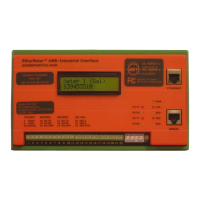6
G. Safety Considerations And Warnings
The following warnings and guidelines should be followed in order to ensure safe operation of your EtherMeter:
• Do not attempt to service the internal circuitry of the EtherMeter. This device contains no user-
serviceable parts or adjustments.
• Carefully inspect the work area in which the EtherMeter will be located to ensure against hazards such as
damp floors, ungrounded power extension cords, and missing ground connections.
• Before operating the EtherMeter, ensure that the external power source is an NRTL-listed power supply
that is rated for a DC voltage between 9 and 36 VDC and rated for a minimum current of 275 mA. If you
are not sure of the type of power source, contact your vendor or SCADAmetrics.
• The secondary output circuits of the EtherMeter are SELV (S
afety Extra Low Voltage). Ensure that the
secondary output circuits are not connected with hazardous energy levels.
• The EtherMeter has been evaluated and NRTL-recognized for use in a Pollution Degree 2 environment.
• The EtherMeter must be examined for compliance with the applicable safety standard after installation
into the final enclosure.
• The EtherMeter must be installed in accordance with all applicable local electrical codes.
• If the EtherMeter is exposed to moisture or condensation, disconnect it from the power source
immediately and obtain service assistance.
• If the EtherMeter exhibits unexpected behavior, such as smoking or becoming extremely hot, disconnect
it from power sources immediately and then obtain service assistance.
• Ensure that the EtherMeter’s cover is secure on completion of installation to reduce safety hazards.
H. Environmental Considerations and Cautions
The following is a list of environmental considerations that will help ensure safe and efficient operation of your
EtherMeter:
• Do not position the EtherMeter near high-powered radio transmitters or electrical equipment, such as
electrical motors or air conditioners. Interference from electrical equipment can cause intermittent
failures.
• Do not install the EtherMeter in areas where condensation, water, or other liquids may be present. These
may cause safety hazards and equipment failure.
I. FCC Class A Notice
This device complies with Part 15 of the FCC Rules.
Operation is subject to the following two conditions:
1. This device may not cause harmful interference.
2. This device must accept any interference received, including interference that may cause
undesired operation.
Note: This equipment has been tested and found to comply with the limits for a Class A digital device, pursuant
to Part 15 of the FCC Rules. These limits are designed to provide reasonable protection against harmful
interference when the equipment is operated in a commercial environment. This equipment generates, uses,
and can radiate radio frequency energy, and if it is not installed and used in accordance with the instruction
manual, it may cause harmful interference to radio communications. Operation of this equipment in a
residential area is likely to cause harmful interference, in which case the user will be required to correct the
interference at his own expense. Modifications: Any modifications made to this device that are not approved by
SCADAmetrics may void the authority granted to the user by the FCC to operate this equipment.
Report: http://scadametrics.com/PDF/EMC26372-FCC.pdf
J. ICES Notice (Canada)
This Class [
1
] digital apparatus complies with Canadian ICES-003.
Report: http://scadametrics.com/PDF/EMC26372-IC.pdf

